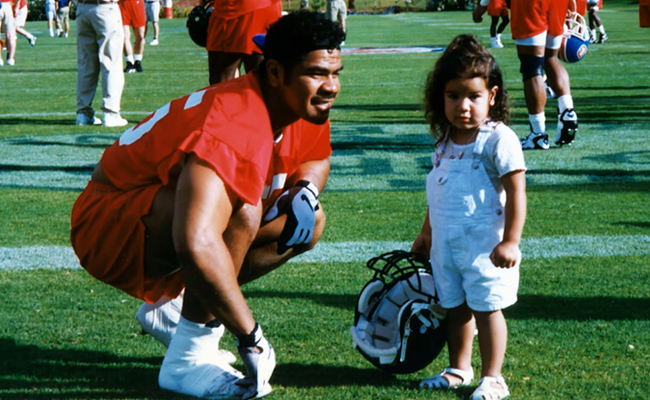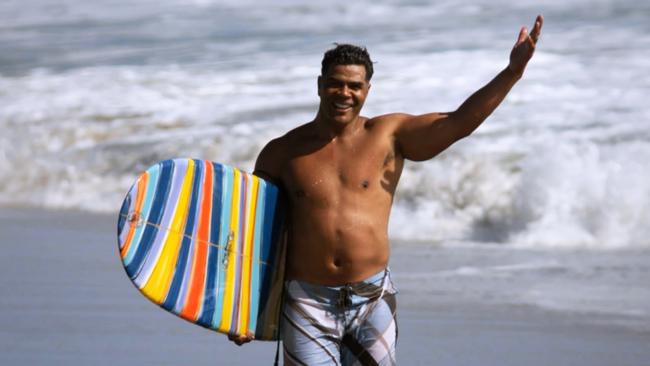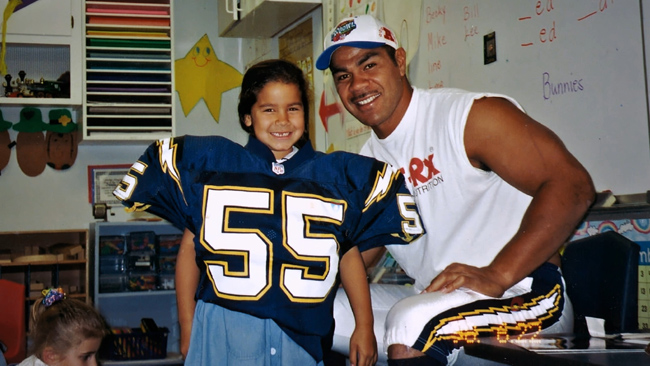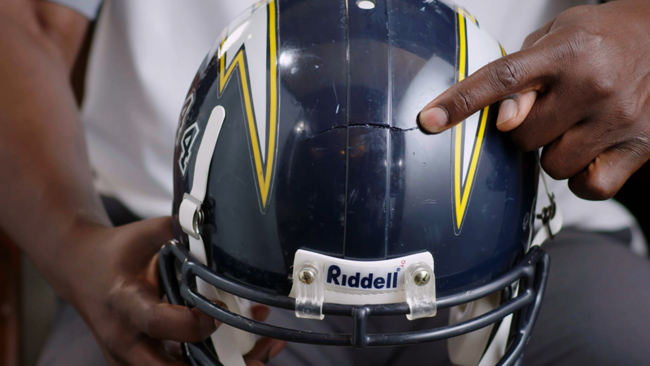
In 2012, when Junior Seau shot himself in the chest at his home in California, he was one of four ex-NFL players to kill himself in just eight months. Even his method of suicide followed an established pattern: he’d shot himself in the chest to preserve his brain for future study, just as former Chicago Bears cornerback Dave Duerson had done 15 months earlier.
There’s something especially cruel about the fact that Junior Seau lived long enough to know so much about CTE despite playing in the days when “shake it off and get back in there” was the kind of advice you could expect from a doctor. Players of his era only learned the true irreversible horror of what they done to their brains long after they’d already done it.
Seau died at 43. Incredibly, he spent 20 years in the NFL, playing all of them before any meaningful concussion protocols were instituted. For my generation, he was probably the first former player to commit suicide while memories of his playing days were still vivid. Certainly, he was the biggest star to go down that road. Seau’s fame as a personality transcended football, especially to anyone who lived in the San Diego area between 1991 and 2010 or so, where his face and name were unavoidable, even during the years he spent playing for Miami and New England.
Seau, a new documentary about Junior Seau, debuts Thursday on ESPN+, ESPN’s new streaming platform. It covers his early days, as a freak high school athlete (excelling not just at football but also basketball, shot put, and just about anything that offered an advantage to someone big, strong, and fast) whose work ethic was just as freakish. Whereas Bo Jackson admitted in You Don’t Know Bo that the lifting he did in his Nike commercials was about the only time he actually spent in the weight room, Seau was known to be finishing his morning workouts when the rest of the team was just showing up — lifting preposterous amounts of weight, even when he was a rookie.
Unavoidably, the film covers Seau’s final days, his ultimate unraveling, and the warning signs we probably should’ve seen along the way, while we were screaming for his sacks and hits. In one particularly resonant sequence, former soccer player and current ESPN analyst Taylor Twellman recounts telling Seau about his own concussion and the subsequent symptoms he was suffering — light sensitivity, and a seemingly constant headache — to which Seau confided, “Man, I’ve had a headache since I was 15.”
It’s anecdotes like that one, between Junior and a guy he happened to share an apartment with in the early 2000s, that make Seau particularly memorable. Being able to dig up those kinds of nuggets is a particular skill, a skill at which Seau‘s director, Kirby Bradley, a veteran sports doc producer, seems to excel.
Normally the difficulty with a documentary is that people don’t film every day of their lives. You sort of have to piece it together after the fact from the spotty public record. In Junior Seau’s case, almost his whole life was lived publicly, and there’s more tape than you could ever watch. Bradley’s job was to find a path through it. And then there’s the more delicate matter of just getting permission to do it, first from a family still grieving, and then from a sports league that up until recently was trying to pretend that CTE didn’t exist.
Bradley managed to do all that, and even more incredibly, discovered that Seau had kept extensive journals. All movies are a combination of careful planning and serendipity, of hard work and sheer luck, and learned that Junior Seau of all people had kept a journal seems a perfect example of the latter. The degree to which Seau — a guy who had to sit out the first year of college because he couldn’t muster the minimum SAT scores — was eloquent and introspective in the writings no one knew he had made before he died, is one of the most shocking parts of the movie.
I spoke to Kirby Bradley by phone this week, about Junior Seau’s exceptional life and all the work that goes into telling a story that on paper might seem like a no-brainer.

—
So first off, what made you want to tell this story?
I had always followed Junior. I had lived in San Diego briefly and that was back when he was in high school and I didn’t really know about him, but I had a roommate who was a sports reporter and his beat was the north county high schools. And he came back one night raving about this huge Samoan kid as a basketball player. And I just thought that was kind of funny. I promptly forgot about him. But years later when he had that breakout year at USC, I was like, “I wonder if that was the same kid?” And sure enough, it was. So I always followed Junior. And I loved his style. I loved that joy of the game and just that intense pleasure you could see he had playing football.
And then when he committed suicide, it was just such a shock. And it just made me think a lot about, what happened? How could this guy who seemed to have everything going for him and seemed to be the least likely guy to kill himself, how could everything fall apart to that level where he did it? I was just intensely interested in the story and wanted to tell it.
You did show part of him being a good basketball player in the movie. What was the process? At what point did he fully switch over and decide to focus on football.
I think it became pretty clear during high school that while he was a great high school basketball player, he didn’t have the body that was going to take him all the way to the NBA. He was not going to be a guard. He would have been a forward, but there aren’t that many 6’4″ forwards or centers in the NBA, so I think they realized that he was built for football. He was like a prototype. And he loved football too. Some people think he loved basketball even more, but he loved football. He loved all sports. He was one of those kids who just loved playing sports. But football was the one where it became clear, that’s where his potential was for going on and earning money doing it, so that’s what he focused on.
Early on, his family realized that this guy could be a professional athlete. How old was he when they figured out that they were going to put him on that track?
He showed great promise really early on, playing baseball and everything. He was fast, he was big, he was just really coordinated. But I think it was when he started high school sports and there was a relatively high level of competition that he just stood out so much from everybody. And we touch on this a little bit in the film, but his dad, they were from a very humble background, didn’t have a lot of money and consequently the kids were all expected to get part-time jobs during school to help defer expenses. Junior never had to do that. His dad said, “Look. Just focus on sports. You don’t have to get that part-time job. Just spend your time practicing and engaging in sports, because you’ve got the potential to develop into something really big.”
There’s a segment in the film where Junior has this encounter with the MLS soccer player who had just had a concussion. How did you find out about that story and how happy were you to discover it?
Yeah. I came across that, I believe it was in a magazine article that I hadn’t seen before where Taylor Twellman was just recounting this relationship he had with Junior. What are the chances? They lived in the same condo building [in Miami] and just became friends. And Junior, as we make pretty clear in the film, was a guy who did not open up to people very often and reveal weakness and reveal doubt. He was one of those guys who just never opened up his inner-self to people, if it involved admitting doubt or weakness or vulnerability or anything like that. So for him to sit with Taylor… and the two cases in the film where we showed Junior showing vulnerability was somebody who revealed vulnerability to him first. And Taylor Twellman tells the story of how he was just suffering these after-effectss of a concussion and was so concerned about what it meant. And once he did that, then Junior unloaded on him about his experiences with concussions. And that line, “I’ve had a headache since I was 15” — it still sends chills down my spine.
So are Junior’s parents still alive? They seemed a little bit notably absent from the movie.
Yeah. I reached out to that side of the family, his siblings and, by extension, the parents. Early on, they seemed to be willing to cooperate, but in the end, they chose not to. And, that’s a tough part of the story to tell, because he loved them, they loved him. There’s no question about that. And I want to make that clear. But at the same time, there were pressures from them. Junior, he was able to handle that when things were going well. But near the end of his life when his brain wasn’t operating at its normal capacity, those pressures contributed I think to some of the issues he had. And what happened to Junior’s family unfortunately, it’s a common story. Not just in sports, but in entertainment and other areas where people from humble backgrounds come into money and it’s really sad, because it’s not uncommon for close family relationships like that to really suffer. And in some cases, they’re broken because the expectations from family members are, they’re just unrealistic. And so, it’s a sad part of the story.

Right. And as you point out in the movie, Samoans are this tight knit community. Was it intimidating to try and get access to such a, let’s say a clannish community, for such a sensitive subject?
Yes and no. There were several people, Paul Paopao in the film and other people who talked to me just as part of the research, and they gave me a lot of really valuable insight into it. I won’t say that they took me deep inside. There’s certainly a part of it that was guarded. I think we had enough to really effectively tell that part of the story. But I think there’s a lot more there that was kept from me for a variety of reasons. But no, there were people who were definitely willing to explain that part of it to me, which I’m thankful for.
I imagine one of the hardest parts about making a film like this is just that you have such a huge mountain of footage to choose from. What were the logistics involved in trying to choose what to put in?
Yeah. Well first of all, ESPN was such a great partner. And probably in retrospect, the only viable partner to do this kind of film, because we just chose to go ahead initially without the NFL’s cooperation. It wasn’t that they didn’t cooperate, we just did it without them, just anticipating that they might have issues with us because of the CTE aspect. And I say that, I’m not saying that they did have issues, we just went and did it without them. And to do that, we would have had to have… well, that’s why I’m saying ESPN is probably the only partner, because they have such a deep library of NFL games and also of footage.
The ESPN people were great. They provided us with support staff to comb through their archives. And we obviously did a lot of research on what games were likely to have the kinds of shots that we were looking for. And the one concussion we focus on that Junior got against the Raiders, I found reference to that in a press account. But there weren’t a lot of other references to hits and so forth. So it was just a function of the ESPN people just spending hours and hours digging through those archives and just looking for the kinds of hits and injuries and so forth. And also, all the great stuff too. The sacks and the interceptions and tackles. It’s just an enormous amount of work. And they were fantastic in doing that.
So going through ESPN meant that you could use footage that they owned without you having to go directly to the NFL?
Well, no. It doesn’t mean that. It’s a good question, but it’s a complicated answer. Going into this, we weren’t sure how the NFL would react. And we assumed that there was a significant chance that the NFL would not cooperate. In other words, if we went to the NFL and said, “Hey. Can we use all your footage about Junior Seau?” So what we chose to do is to make the film first and then go to the NFL. And at the end of the day, the NFL signed off on all of our footage. And ESPN decided that they would pay for it. There’s another route to take, not to get too deep in the woods, as far as how these things work, but the other approach is to use a legal doctrine called fair use, where courts have determined that video media outlets can show footage of something that’s news worthy and relevant to the story you’re telling without clearing it or paying for it.
But there are complications with that too. The doctrine is clear, but each case is, it’s not obvious exactly what you’re allowed to do. And that would certainly anger the rights holder of the footage. So, ESPN considered that as well. Just based on prior history, we’re fairly sure that at the end of the day, the NFL would okay the footage, as long as ESPN was paying for it, like they typically do in any kind of project. And that’s how it worked out.
How much did Junior Seau’s death play a role in that, in terms of, it seems like he was one of the milestones of making the NFL have to acknowledge that CTE was a thing. Do you think that that played into them being more amenable to letting you do this movie?
You’d have to ask them about that. I don’t really know. I think it’s fair to say and accurate to say that Junior’s death brought this issue more to the forefront. It’s not like it wasn’t newsworthy before then. Dave Duerson, the player who killed himself a year earlier, that was a big story too. But Junior was kind of on a different level. And he was such an unlikely person. He was so charismatic and happy and positive and all that. He would have been voted the least likely player to do this. And then when he did it, it was such a shock. So I think that it put the issue up to the forefront. And the NFL, like Chris Nowinski in the film says, the NFL just, they had to deal with it. They were forced to acknowledge it. And I just want to make clear that I’m not one of those people who wants the NFL to be banned or anything. I think that the NFL, I think it’s accurate to say that for a long time, the NFL just tried to brush this issue under the rug. They wouldn’t acknowledge it for a long time. They attacked the messenger for those of us who covered this story of CTE. I think it’s fair to say now they’re acknowledging it to some extent. And they’re certainly taking steps to try to reduce concussions.
The challenge for them, even now and going forward is that, so far, those significant rule changes that they’ve implemented to try to reduce the number of helmet to helmet hits and hits to the head of all kinds, they’ve not been effective in reducing the number of concussions at all. Even by the NFL’s own measurements. So that’s a conundrum that the NFL faces. And I’m someone who loves the game. But I don’t know what the solution is. And I’m sure the NFL is facing that same challenge. So that’s part of what the film is about, is that this is a cautionary tale. Junior, it’s a story about what can happen to an NFL player. And I think that’s still true. In spite of the changes that have taken place in the game. I think that what happened to Junior can still happen to any player today. And that’s a little bit scary.

I’m an ex-rugby player, so I have my own biases in this regard, but it doesn’t seem like we hear that much about CTE with ex-professional rugby players. Has there been any talk about maybe removing some of the helmet equipment that they’re using? Because it almost seems like it’s making it worse?
Well, yeah, you’re asking if there’s some talk. Yes, on the fringes, there are people who are proposing, “Well, why don’t you go back to the leather helmet days, or even remove helmets,” and the use rugby as the example, because when you don’t have any head protection, you obviously avoid head contact at almost any cost. But, that’s never going to happen. That’s just not the NFL. They’re not going to change the game that much. And you’re right, unless you change it to touch football or flag football, there’s only a limited amount you can do to legislate head trauma and concussions out of the game. And I don’t know that you can go far enough to do that without completely changing the game, which would make it… well it wouldn’t be the game that it is now.
And I want to say something else. You brought up rugby. But there are other sports [in which CTE is an issue] as well. We focus on the NFL because the NFL is the biggest game in town in the US, but CTE is an issue we’re finding more and more in hockey and in soccer. And there are other contact sports that — boxing obviously — where it’s an issue too. But we’re focusing on the NFL because it’s by far the biggest sport out there. And also just the number of players is much bigger than it is in other sports too. But it doesn’t mean that’s the only sport that faces these same issues.
Anecdotally, I’ve been hearing people talk about not having enough kids to fill Pop Warner teams in some places. How soon are we going to start seeing actual effects on the game?
Yeah. I think the information on that issue is really incomplete. You’re also hearing the same reports about declines in little league baseball. So I don’t know. Yes, there’s a decline in youth football. There’s no question. But I don’t know that we can definitely say it’s because of concerns over head trauma. I wouldn’t be surprised. But that doesn’t explain why youth baseball is declining too. I think there are a lot of variables here and I don’t think we can ascribe, we can give a cause and effect yet on CTE and the concerns about that. Anecdotally, I think you’re right. There’s no question that more and more parents are holding their kids out. I would if my son were interested in youth football, especially youth tackle football, I don’t think I would allow him to do that. But then, what does that mean to the game? Is it a game that attracts, kind of the way that boxing has where it only attracts people from a lower socio-economic background? Again, we’re not deep enough into it to know the answers to those questions yet, so it’s only speculation, but there’s definitely an issue out there that people need to think about. And that’s what I hope the film does.
It seems like Junior still comes from that era where it seems like, “Well no one even told us about this,” and it felt like a betrayal to some degree.
Exactly. And I think early in his career, beginning in 1990, you could argue that, “Well, no one really knew enough to make draw any conclusions.” But by the end of his career, which is an incredible 20-year career, by the end of that, it’s indisputable that there was enough scientific information out there to really point in the direction that there was something serious going on here and people should factor that knowledge into their decisions. That wasn’t happening yet. It’s beginning to happen now. But it’s not nearly to the extent that you might think.
One of the aspects of CTE is that it creates mood imbalances and personality changes. Do you find people grappling with how much to blame Junior for the ways that he acted in his last years?
Well, I think that for most people who were close to him, it was just confusing at the time, because it just didn’t seem to fit into the pattern of Junior’s life. Now Junior, again, Junior was not a perfect man. He was incredibly loved, he was incredibly positive, but like any of us, he had weaknesses in his life and Junior had a temper. I think every NFL player has a side of him that is violent. You have to in order to excel at the game. But earlier in his life, he was able to control those impulses. He was able, I think he probably was somebody who was going to be prone to some degree of depression. Depression is a widespread condition that many of us face. And I think CTE … I think we know enough about it now that it’s reasonable to say that CTE makes your challenges harder. And if somebody is prone to depression, you’re probably going to have more issues with depression than you might have otherwise.
Are there any sort of CTE treatments that appear promising?
Not to treat the disease itself, as far as I know. What Junior’s friends and family say is, “Look, if we knew he had this disease, we could have gone to him and hopefully convinced him to get counseling, to do the things that you do to treat depression, to do the things that you do to treat alcoholism.” But who knows? If your brain is not working right, are you going to be able to react logically to your friends and family members who are trying to convince you? Who knows? He may have just rejected them.
But their reaction is, “If we’d only known, we could have done something.” Maybe. But maybe not. It’s impossible to know.
‘Seau’ premieres Thursday, September 20th on ESPN+. Vince Mancini is on Twitter. More reviews here.






